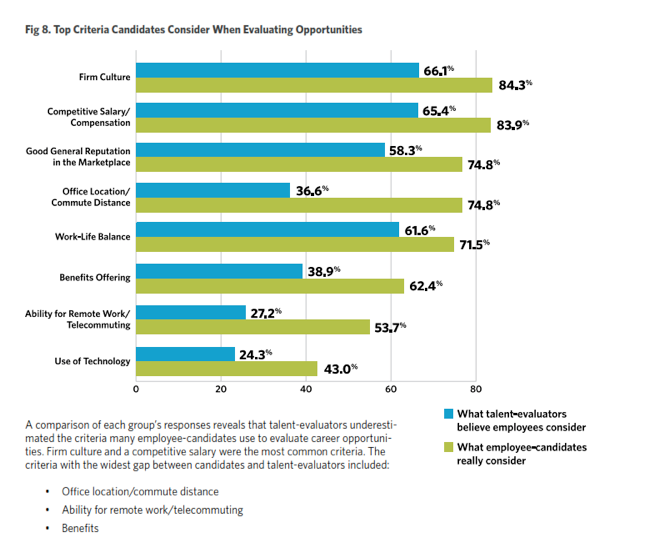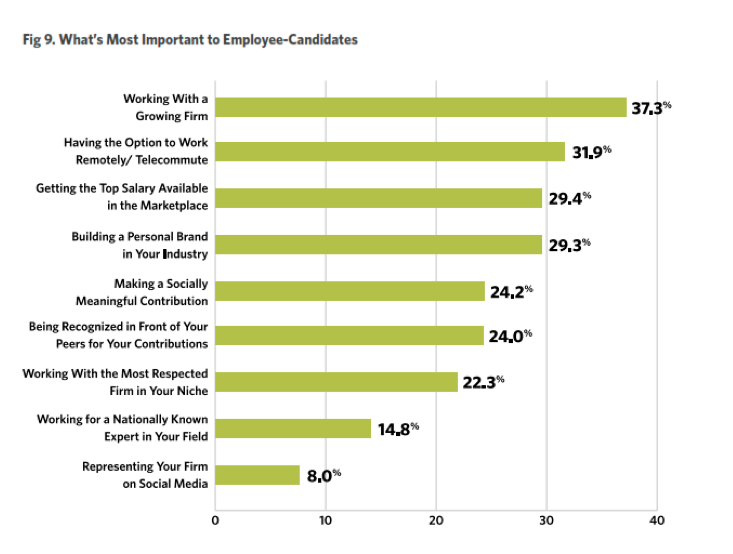To Recruit Top Talent, Check Your Preconceived Notions at the Door

If you’re in management at a professional services firm, you don’t need anyone to tell you how hard it is to recruit top talent. Competition for the best people is hotter than ever as markets rapidly evolve and the supply of top-quality, experienced professionals tightens.
In response to the increasing importance of recruiting and retaining top professional talent, the Hinge Research Institute conducted a study on an emerging trend in the professional services marketplace: employer branding.
Over 800 professionals responded to Hinge’s survey on how to recruit top talent. Based on their roles in the recruiting process, respondents were asked questions from one of two perspectives:
– as talent evaluators involved in their firm’s recruiting and hiring process
– or as candidates searching for and evaluating potential career opportunities.
The survey results provided some surprising insights into the process of offering and evaluating employment opportunities.
What Is Employer Branding and Why Is It Important?
We should start by providing a definition of employer branding and discussing its importance for recruiting and retaining top professional talent.
Simply put, your employer brand is your reputation as a place to work. An employer brand offers a view of a firm’s culture and a glimpse of what it’s like to work there. It can create a general impression (“It’s a great place to work”) and highlight specific attributes (“They really promote a work/family balance”).
There are two basic elements that help form an employer brand: reputation and visibility. Reputation, of course, is how a firm is viewed in the market. For example, is it innovative or old-fashioned? Do they nurture talent or do they have a revolving door? Reputation is a measure of how attractive a firm might be to potential employees.
Visibility is how well known a firm is in the market and to prospects. Is it high profile, with a reputation to match? Or is it virtually unknown, struggling to gain the attention of qualified prospects?
As growing numbers of professional services firms realize the importance of their employer brands in attracting and retaining top talent, marketing departments are nurturing the kinds of positive brands they think will appeal most to top candidates. Interestingly, our survey revealed that what talent evaluators think are key employment criteria for candidates are not necessarily what actually appeals to said candidates.
Far and away, what matters most to candidates is the firm’s culture (84.3 percent) – what it is like to work there, what the firm values, how supportive the employer is, and how the other employees work. In this case, the talent evaluators got it right (66.1 percent), naming it a very close first on the list of what candidates value. The next biggest consideration for employment – not surprisingly – is compensation. Almost 84 percent of candidates listed it as a top criteria, as compared to 65.4 percent of talent evaluators.
Where the gap really began to widen was in office location and commuting distance. While almost 75 percent of candidates listed these as major concerns, only 36.6 percent of the talent evaluators thought location was important to candidates. Likewise, almost 54 percent of candidates considered telecommuting a big plus, while just about 27 percent of talent evaluators thought it was important to prospects.

What Matters Most to Candidates
The survey offered candidates nine possible employment benefits (see figure below). Surprisingly, top salary came in as the third most attractive benefit. The top preference was the ability to work with a growing firm. Second was work flexibility, with the option to telecommute and work remotely.

Candidate preferences tend to differ between generations. Baby boomers, nearing the end of their careers and perhaps tired of paying their dues working for less-than-ideal employers, tend to prioritize working for the most respected firms in their niches. Gen. X-ers, now reaching middle age, yearn most to be recognized in front of their peers for their professional contributions. Millennials, raised on the internet and just starting out, are most interested in being able to build their personal brands to increase their visibility and value in the market.
How to Recruit Top Talent: Where They’re Looking and Why
Depending on the expertise and experience level you prefer in potential employees, you’ll need to choose your outreach channels based on generation.
Baby boomers prefer physical networking and asking colleagues for recommendations. Gen. X-ers as well still lean toward an old-school approach, using industry publications to source jobs. They even prefer Facebook, now the domain of an older audience, using it twice as much as baby boomers and millennials. Millennials generally turn to online job boards, perhaps because they’re more adept at manipulating search terms and navigating websites.
The key takeaway for talent evaluators is to check any preconceived notions at the door about candidate preferences. Look a little closer at generational differences to make the kinds of offers needed to attract and retain top talent.
Elizabeth Harr is partner at Hinge Marketing.

